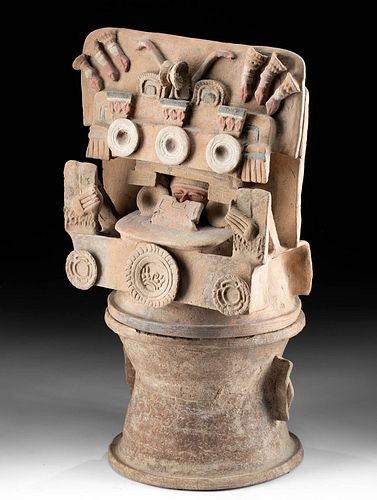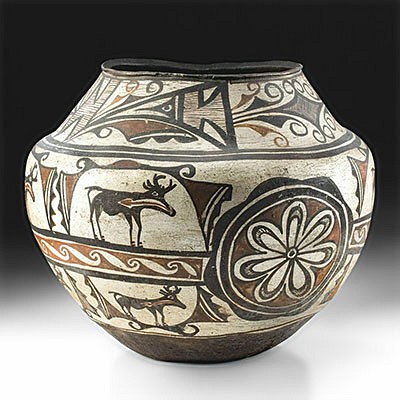Teotihuacan Pottery Lidded Incensario, ex Sotheby's
Lot 97
About Seller
Artemis Fine Arts
686 S Taylor Ave, Ste 106
Louisville, CO 80027
United States
Selling antiquities, ancient and ethnographic art online since 1993, Artemis Gallery specializes in Classical Antiquities (Egyptian, Greek, Roman, Near Eastern), Asian, Pre-Columbian, African / Tribal / Oceanographic art. Our extensive inventory includes pottery, stone, metal, wood, glass and textil...Read more
Categories
Estimate:
$9,000 - $13,500
Absentee vs Live bid
Two ways to bid:
- Leave a max absentee bid and the platform will bid on your behalf up to your maximum bid during the live auction.
- Bid live during the auction and your bids will be submitted real-time to the auctioneer.
Bid Increments
| Price | Bid Increment |
|---|---|
| $0 | $25 |
| $300 | $50 |
| $1,000 | $100 |
| $2,000 | $250 |
| $5,000 | $500 |
| $10,000 | $1,000 |
| $20,000 | $2,500 |
| $50,000 | $5,000 |
| $100,000 | $10,000 |
| $200,000 | $20,000 |
About Auction
By Artemis Fine Arts
Nov 18, 2021
Set Reminder
2021-11-18 10:00:00
2021-11-18 10:00:00
America/New_York
Bidsquare
Bidsquare : Art & Artifacts of North America
https://www.bidsquare.com/auctions/artemis-gallery/art-artifacts-of-north-america-7894
Join us for a special auction not to be missed! Collectible Native American art from antiquity to mid-20th century, Spanish Colonial, Latin American, Pre-Columbian, fine & folk art, American frontier items, fossils, and much more! Artemis Fine Arts info@artemisgallery.com
Join us for a special auction not to be missed! Collectible Native American art from antiquity to mid-20th century, Spanish Colonial, Latin American, Pre-Columbian, fine & folk art, American frontier items, fossils, and much more! Artemis Fine Arts info@artemisgallery.com
- Lot Description
Pre-Columbian, Mexico, Pacific Slope region, Teotihuacan culture, Escuintla type, Classic Period, ca. 450 to 650 CE. A stunning incensario used to burn copal incense, presented in the form of a Teotihuacan priest housed within an ornate architectural structure. The base of the two-part incensario is of a minimalist form and features a pair of tab-shaped flanges with circular ornamentation as well as a trapezoidal frontal ornament that is similar to the nose ornament worn by the priestly figure on the top portion. Within the flush canopy is a priest with a pensive, red-painted visage donning massive earspools and a grand headdress behind an ovoid frontal platform. His hands are presented on the lateral flanges protruding up from the frontal panel - replete with a trio of intricate, mold-formed appliques - and the surfaces above bear additional spools as well as red diamonds, a corseted central cylinder, and a pair of eye-like forms beneath dramatically arching brows. Presented in hues of red, azure, cream, yellow, and black atop the buffware surfaces, this is a sumptuous and functional piece of Teotihuacan religious artistry! Size: 12" W x 20.875" H (30.5 cm x 53 cm)
This censer is known as a "theater type" and is among the most emblematic articles of visual culture of Teotihuacan, which then inspired contemporaries and the civilizations that came after them. These were first created in the Tzacualli period (1 to 100 CE), and during the following years, artisans created more and more intricate compositions. Molds were used to make various ornaments that were glued to the primary body and the plates were arranged in superimposed planes as we see in this example. They are known as "theater" because they seem to represent the architecture of a temple, with the mask at the center representing the deity within the temple. Numerous scholars have suggested that censers like this example were instrumental to a cult dedicated to warriors killed in combat. Incense played a major role in religious practice in Mesoamerica, from the Olmec onward. Many tombs are outfitted with incensarios and the items also seem to have been used in ceremonies by the living. The incense was made from copal, tree resin from the torchwood tree. By burning copal, Mesoamerican priests made an offering to the gods - for example, during an Aztec ceremony for the god Huitzilopochtli, the hummingbird-formed god of war, priests hoped that their prayers would be carried upward along with the wafting smoke and scent.
Cf. "The World Beyond, Maya Tomb Ceramics." Epcot Center, Walt Disney World, 1984, fig. 27, for the type.
This piece has been searched against the Art Loss Register database and has been cleared. The Art Loss Register maintains the world’s largest database of stolen art, collectibles, and antiques.
Provenance: private New York, New York, USA collection; ex-private Canadian collection; ex-Sotheby's, New York "Pre-Columbian Art" auction (sale 7224, November 23, 1998, lot 147)
All items legal to buy/sell under U.S. Statute covering cultural patrimony Code 2600, CHAPTER 14, and are guaranteed to be as described or your money back.
A Certificate of Authenticity will accompany all winning bids.
PLEASE NOTE: Due to recent increases of shipments being seized by Australian & German customs (even for items with pre-UNESCO provenance), we will no longer ship most antiquities and ancient Chinese art to Australia & Germany. For categories of items that are acceptable to ship to Australia or Germany, please contact us directly or work with your local customs brokerage firm.
Display stands not described as included/custom in the item description are for photography purposes only and will not be included with the item upon shipping.
#164566Lower body has extensive repairs and restoration to basin walls and frontal surfaces along top half; upper half has extensive repairs and restoration as well; all with resurfacing and overpainting along new material and break lines. Softening to some finer details, with fading to original pigment, light encrustations, and chips to some protruding areas and ornamentation. Great preservation to overall form as shown.Condition
- Shipping Info
-
All shipping is handled in-house for your convenience. Your invoice from Artemis Gallery will include shipping calculation instructions. If in doubt, please inquire BEFORE bidding for estimated shipping costs for individual items.
-
- Buyer's Premium



 EUR
EUR CAD
CAD AUD
AUD GBP
GBP MXN
MXN HKD
HKD CNY
CNY MYR
MYR SEK
SEK SGD
SGD CHF
CHF THB
THB














